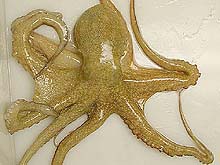
This octopus was captured in an “Otter” trawl during the evening. This type of trawl is designed to collect organisms living on the ocean floor. Click image for a larger view.
Modern Submersibles
August 07, 2002
Mike Randall, Biologist
US Geological Survey/ AsCI Corp.
Tara Nye, Research Biologist
North Carolina National Estuarine Research Reserve
Ann Marie Necaise, Research Biologist
North Carolina National Estuarine Research Reserve
For hundreds of years, fisheries scientists has been restricted to the surface waters. To sample the depths of the ocean, they developed multiple techniques and gear. Today, even with the advent of occupied submersibles and remotely operated vehicles (ROVs), almost all types of traditional gears are still used because they still provide valuable information in connection with submersible and ROV operations.
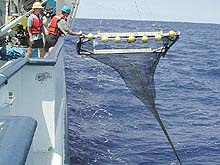
The large aluminum frame of the neuston net is 1 meter high and 3 meters long. Here the net is being deployed off the starboard side of the R/V Seward Johnson. Click image for a larger view.
Occupied submersibles and ROVs provide valuable information on fish community structure and habitat usage at a particular point in space and time. Using subs and ROVs, scientists can learn vast amounts of information about a relatively small area, essentially the sphere of vision surrounding the observer. On a typical three-hour submersible dive aboard the Johnson-Sea-Link II, observers might have a “tunnel of sight” into the ocean that is approximately 60 feet in diameter by several hundred yards long. Turbidity, however, can reduce that sphere of visibility to twenty feet or less. In addition, the cameras mounted on the subs and ROVs record a much smaller area than the sub observer can see. A typical sub dive descends to an area of interest, and moves slowly across it, exploring in great detail. Samples can be collected with precision (we can target and collect a specific fish that is observed), but we must sacrifice the ability to collect specimens over large areas and in high quantities (we can’t collect all the fish in an area, or even a representative sample). The type of data collected via sub and ROV operations is known as qualitative data, and includes information such as presence or absence of species, their behaviors, and the interactions occurring between different species.
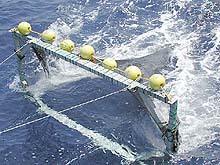
The neuston net is designed to sample the organisms living at the very surface layer of the ocean. The yellow floats on top of the frame insure that it will not sink any lower that 1 meter below the surface. Click image for a larger view.
Traditional scientific collecting gears were designed to sample fish communities of interest over larger areas. Traditional gears trade precision for quantity. Net sizes range from 50-cm-diameter plankton nets to huge trawls. Distances towed range from hundreds of yards to miles. The amount of area swept by the tow is known, and the amount of catch can be correlated to area or effort, which allows us to compare different areas. We use five types of net gear to sample depth ranges from the surface to sub-bottom, and to sample size ranges of organisms from microscopic to large fish. The five types of gear are plankton nets, neuston nets, tucker trawls, otter trawls, and dredges.
The plankton nets we use, depending on the net mesh size, capture phytoplankton (microscopic algae that form the base of the oceanic food chain) or zooplankton (organisms that feed on phytoplankton). A plankton net resembles a windsock. It has a stainless steel ring with a cone of mesh, ending with a collecting cup on the bottom. These nets can be deployed at any depth.
Neuston nets were devised to collect fish at the surface. They consist of a tapering net attached to a rectangular metal frame (ours is 1 X 3 meters). The neuston net skims the surface down to a 1-m depth. We often use the neuston net to sample sargassum communities, which are floating mats of seaweed that provide habitat for large numbers of fish, especially juveniles.
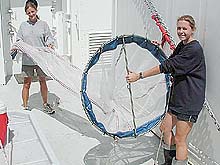
The fine mesh of this plankton net allows us to capture the smallest of marine organisms including marine algae, larval fish and invertebrates. Click image for a larger view.
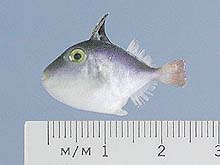
This juvenile trigger fish (family Balistidae) was captured near the surface in a neuston net. These fish normally live in tropical areas, but are occasionally advected north by the Gulf Stream. Click image for a larger view.
To sample midwater communities, we used tucker trawls. These are large square frame nets designed to sweep a path through the water at a known depth. They can be sent down to a specific depth closed, and triggered to open so that only a known depth range is sampled. These nets are often used to study daily vertical migrations of fish through the water column, indicating to scientists where the fish are in the water column at what time of day.
An otter trawl consists of a tapering, rectangular net attached to metal or wooden doors that use water resistance to keep the net open as it is pulled through the water. Trawls drag across the bottom, collecting fish and invertebrates from the bottom to a few meters above. Finally, dredges collect bottom-dwelling organisms, cutting a few centimeters into the bottom, and extending less than half a meter above the bottom.
The two types of sampling complement each other. The traditional gears have limitations in that the scientists cannot tell when the organisms in the net were caught, or in what habitats, during a tow. Also, fish that can outswim the nets are rarely caught and slow organisms are caught often. However, scientists can sample large areas and obtain quantitative data on the fish—data such as average size and relative abundance—that cannot be obtained during a sub dive. The sub, however, can fill in these data gaps by allowing the scientists to take a good look at how the fish communities interact and associate within different habitats.
Using traditional gear in combination with submersibles and ROVs provides scientists a more complete picture of the ocean habitats that they study. It allows them to collect detailed information on fish from the surface to the bottom, and both quantitative and qualitative data on fish communities of interest.
Sign up for the Ocean Explorer E-mail Update List.














































